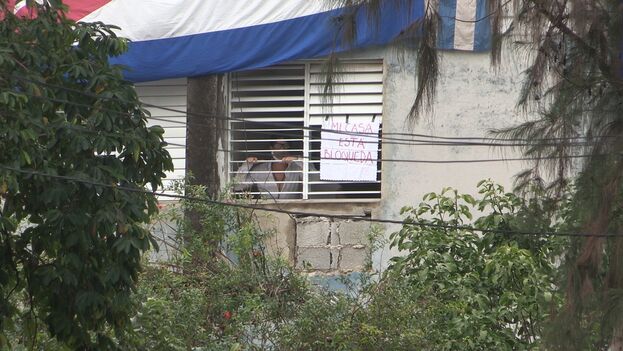
![]() 14ymedio, Luz Escobar, Havana, 14 November 2021 — The playwright Yunior García Aguilera could not carry out his plan to walk dressed in white with a rose in his hand at 3 o’clock in the afternoon down 23rd Street in El Vedado to the Malecón in Havana.
14ymedio, Luz Escobar, Havana, 14 November 2021 — The playwright Yunior García Aguilera could not carry out his plan to walk dressed in white with a rose in his hand at 3 o’clock in the afternoon down 23rd Street in El Vedado to the Malecón in Havana.
Police and State Security agents and members of the Rapid Response Brigades prevented him from setting foot on the street, tried to completely cover his window by displaying Cuban flags and kept the international press who had approached his house as far away as they could, expelling them violently from the start.
More than an hour after the scheduled time for García Aguilera’s walk, it is unknown what his personal situation is due to the communication cuts maintained by the Government, but it is a fact that the activist could not carry out his solo march.
“This outside the house is very violent, they have attacked the press, they were simply parked with their car and a mob was on them,” Dayana Prieto, Garcia’s wife, reported to 14ymedio this morning. “Since the early hours of the morning they have been gathering in the school that is across from the house and on the ground floor of the building,” she added.
“Right now they have just expelled some journalists who arrived in a car, they carried out an act of repudiation, they refused to leave, they began to yell ‘get out’, to push the car until finally they made them leave, they are already in a violent mode,” said the playwright in an audio shared with the Archipiélago platform.
“Nobody here in the house now has mobile service of any kind,” Garcia’s wife explained a few minutes later to 14ymedio. “At front of the door of our apartment there are many people and everything is surrounded by siege, I can see it through the blinds. There are full buses, many cars, I think there is a group on the corner that seems to be from the press because of their credentials but without cameras, I don’t know if they have been forbidden to use them.”
García had also denounced the siege in a Facebook transmission: “Today my house was under siege, the entire building is surrounded by State Security agents dressed in civilian clothes posing as ’the people’, as they usually do, that does not surprise any Cuban. There are cars on every corner and groups even in my building in the stairwell.”
“They know that I was going to do a solo march carrying a white rose down 23 Avenue from Parque Quijote to the Malecón, that does not violate any right, on the contrary, it is my human and constitutional right to walk as a free citizen carrying only a white rose, but apparently they are not even willing to allow that,” he lamented.
“When the time is right I will leave my house despite the fact that there is a mob surrounding it, despite the fact that we have already seen the violence against these accredited journalists.” García believes that “in recent years we have seen how this violence grows and how this hateful language grows, how this discrimination grows and how this ideological apartheid grows.”
To define the prevailing model on the island, the activist remarked that “it is not even the rule of law nor is it a republic nor is it anything, it is a tyranny,” and he asked that at three in the afternoon Cubans applaud. “A clap for us, for the people of Cuba, we have spent too much time applauding others, applauding leaders, applauding figures with power. It is time to applaud that desire for freedom and this joy that we have.”
With regards to the expulsion of the foreign correspondents that both saw from the apartment window, the activist of the Archipiélago platform details that it was “with shouts and blows (…) that they were repudiated, they they expelled them, they refused to leave because they have every right, but they even tried to push the car to get it off the block and finally they made them leave with shouts, threats.”
“We are living very ugly days in Cuba, unfortunately we are going back to the worst times; to the times that Cuban artists know very well … that grey five-year period, those acts of terrible repudiation between some Cubans and others,” García commented in reference to to the years between 1971 and 1975 when censorship was extended to the island’s cultural policy.
“Some young people are allowed, for example, to demonstrate in Central Park because they are favorable to what they call revolution, because it stopped being so a long time ago and it has removed all its masks because it has been shown that it is a very conservative dictatorship, they are allowed to demonstrate, to block the statue of the national hero who is the hero of all Cubans, which was not the private property of anyone, and we are not,” allowed to get near it, he denounced.
On Saturday night, a group that identifies itself as “Los Pañuelos Rojos” [the red scarves] held a “sit-in” in Central Park, right in front of the statue of José Martí. Elízabeth Rodríguez, one of the coordinators of this project, stressed to Radio Reloj the marked “anti-imperialist character” of the initiative, which, as she specified, will last 48 hours.
____________
COLLABORATE WITH OUR WORK: The 14ymedio team is committed to practicing serious journalism that reflects Cuba’s reality in all its depth. Thank you for joining us on this long journey. We invite you to continue supporting us by becoming a member of 14ymedio now. Together we can continue transforming journalism in Cuba.
